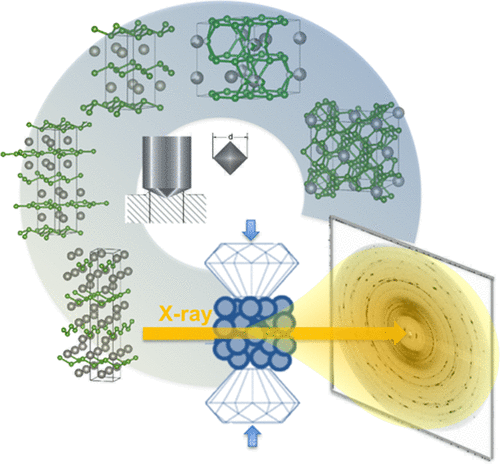当前位置:
X-MOL 学术
›
Acc. Mater. Res.
›
论文详情
Our official English website, www.x-mol.net, welcomes your
feedback! (Note: you will need to create a separate account there.)
Hardening Effects in Superhard Transition-Metal Borides
Accounts of Materials Research ( IF 14.0 ) Pub Date : 2021-12-30 , DOI: 10.1021/accountsmr.1c00192 Lisa E. Pangilinan 1 , Shanlin Hu 1 , Spencer G. Hamilton 1 , Sarah H. Tolbert 2 , Richard B. Kaner 2
Accounts of Materials Research ( IF 14.0 ) Pub Date : 2021-12-30 , DOI: 10.1021/accountsmr.1c00192 Lisa E. Pangilinan 1 , Shanlin Hu 1 , Spencer G. Hamilton 1 , Sarah H. Tolbert 2 , Richard B. Kaner 2
Affiliation

|
Mechanical hardness is a physical property used to gauge the applications of materials in the manufacturing and machining industries. Because of their high hardness and wear resistance, superhard materials (Vickers hardness, Hv ≥ 40 GPa) are commonly used as cutting tools and abrasives. Although diamond is the hardest known material used for industrial applications, its synthesis requires both high pressure and high temperature. Interest in the field of superhard materials research has led to the search for alternatives with high hardness and thermal stability at low cost. The discovery of novel ultraincompressible, superhard materials has largely developed through trial and error along two paths. In one approach, researchers combine light elements, such as boron, carbon, nitrogen, and oxygen, often at high pressure, to replicate the highly directional, dense, covalent bonds of diamond. In the second approach, these light elements (B, C, N, and O) are combined with highly incompressible, electron-rich transition metals to form dense covalently bonded networks at ambient pressure.
中文翻译:

超硬过渡金属硼化物的硬化效应
机械硬度是用于衡量材料在制造和机械加工行业中的应用的物理特性。由于它们的高硬度和耐磨性,超硬材料(维氏硬度,H v≥ 40 GPa) 常用作切削工具和磨料。尽管金刚石是用于工业应用的最硬的已知材料,但其合成需要高压和高温。对超硬材料研究领域的兴趣促使人们以低成本寻找具有高硬度和热稳定性的替代品。新型超不可压缩、超硬材料的发现在很大程度上是通过两条路径的反复试验而发展起来的。在一种方法中,研究人员通常在高压下结合硼、碳、氮和氧等轻元素,以复制金刚石的高度定向、致密、共价键。在第二种方法中,这些轻元素(B、C、N 和 O)与高度不可压缩的元素相结合,
更新日期:2022-01-28
中文翻译:

超硬过渡金属硼化物的硬化效应
机械硬度是用于衡量材料在制造和机械加工行业中的应用的物理特性。由于它们的高硬度和耐磨性,超硬材料(维氏硬度,H v≥ 40 GPa) 常用作切削工具和磨料。尽管金刚石是用于工业应用的最硬的已知材料,但其合成需要高压和高温。对超硬材料研究领域的兴趣促使人们以低成本寻找具有高硬度和热稳定性的替代品。新型超不可压缩、超硬材料的发现在很大程度上是通过两条路径的反复试验而发展起来的。在一种方法中,研究人员通常在高压下结合硼、碳、氮和氧等轻元素,以复制金刚石的高度定向、致密、共价键。在第二种方法中,这些轻元素(B、C、N 和 O)与高度不可压缩的元素相结合,











































 京公网安备 11010802027423号
京公网安备 11010802027423号